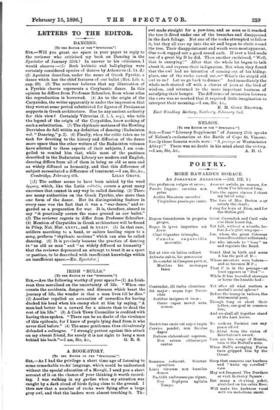LETTERS TO THE EDITOR.
DANCING.
['o THE EDITOR OF TIM " SPECTATOR.-]
SIR,—Will you grant me space in your paper to reply to the reviewer who criticised my book on Dancing in the Spectator of January 25th? In answer to his criticisms, I world observe :—(1) Both kubistic and ball-playing were certainly considered species of dances by AthenEens (I. 14. d.) <2) Apuleius describes, under the name of Greek Pyrrhic, a dance which has the chief features of our ballet (Met. Lib. x. cap. 29). (3) The reviewer believes that my illustration of a Pyrrhic chorus represents a Corybantic dance. In this opinion he differs from Professor Schreiber, from whose atlas the reproduction is borrowed. (4) As to the origin of the Caryatides, the writer apparently is under the impression that they were at some period substituted for figures of Persians as supports in Greek architecture. Has he any ancient authority -for this view P Certainly Vitruvins (I. i. 5, seq.), who tells the legend of the origin of the Caryatides, knew nothing of such a substitution. (5) The rhythmic motions of the Howling Dervishes do fall within my definition of dancing (Badminton vol. " Dancing," p. 2). (6) Finally, when the critic takes me to task for devoting to the history and diffusion of the dance more space than the other writers of the Badminton volumes have allotted to these aspects of their subjects, I am com- pelled to remind him that, while most of the pastimes described in the Badminton Library are modern and English, dancing differs from all of them in being as old as man and as widely diffused as humanity, and that this difference of subject necessitated a difference of treatment.—I am, Sir, &c., [(1) The author seems to have been misled by the word tipplers, which, like the Latin saltatio, covers a great many -exercises that cannot in any way be called dancing. (2) There are many authorities on the Greek Pyrrhic, also more than one form of the dance. But its distinguishing feature in .every case was the fact that it was a " war-dance," and re- garded as a preparation for war. It is, therefore, absurd to say "it practically covers the same ground as our ballet."
43) The reviewer regrets to differ from Professor Schreiber.
44) Mention of Caryatides in Greek architecture will be found in Pliny, Nat. Hist. xxxvi., and in xxxtv. (5) In that case, soldiers marching to a band, or sailors hauling ropes to a song, perform "rhythmic motions" which can also be called dancing. (6) It is precisely because the practice of dancing is " as old as man" and " as widely diffused as humanity " that the reviewer deprecated an attempt to treat it as a sport or pastime, to be described with insufficient knowledge within an insufficient space.—En. Spectator.]


































 Previous page
Previous page